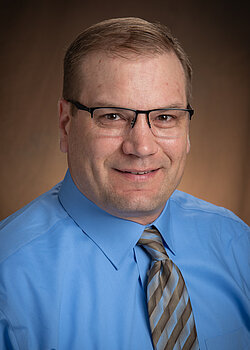NDSU strengthens central core research facilities through new leadership and reorganization
Scott Payne promoted to Executive Director of Core Research Facilities

In line with peer Carnegie R1 institutions, NDSU’s Office of Research and Creative Activity has reorganized the unit’s two core facilities, now unified under the executive leadership provided by Scott Payne, PhD. These efforts are squarely in line with President Cook’s priority to maintain R1 status and align with NDSU’s strategic plan, which prioritizes as a goal the integration and strengthening of centralized administrative and academic support for research and creative activity.
With this reorganization, the RCA Core Research Facilities represent two distinct sets of facilities and capabilities, the EMC and the Materials, Fabrication Analysis and Fabrication Core, the latter formerly known as Research Operations. The EMC houses and provides services for the university's electron microscopy, micro computed X-ray tomography, and imaging equipment used for teaching, research, and industry activities.
The Materials Characterization, Analysis and Fabrication Core (MCAF) services consist of more than 130 materials synthesis and characterization, microfabrication, device packaging, and testing equipment sets used by NDSU faculty, staff, students, and external academic and industry users (instrumentation description below). The MCAF Core is staffed by three highly skilled technicians and engineers (James Bahr, Fred Haring and Greg Strommen), with instrumentation located in buildings Research 1 Addition (R1A) and Research 2 (R2) in the NDSU Research & Technology Park.
The two Cores serve more than 120 NDSU researchers and students from 20 departments across five NDSU colleges and 20 external companies. On average, this work is a component in 125-175 publications and 30-40 dissertations/theses annually. The new Executive Director role will manage all responsibilities and employees from both teams.
Payne has been promoted to Executive Director of Core Research Facilities at NDSU to provide leadership to the Cores. Previously, he served as Director of the Electron Microscopy Core (EMC). Payne received his doctorate in materials from NDSU and began working at the EMC in 1995. After developing expertise in micro-computed X-ray tomography and scanning and transmission electron microscopy, he accepted the lead for the facility upon retirement of the previous Director in 2008. In early 2023, Payne assumed overload duties as the Interim Director of Research Operations for the Office of Research and Creative Activity when the previous director, Aaron Reinholz, moved into a new role in Agriculture Affairs.
During the past 16 years, Payne's efforts have made the facility a world-class scientific core facility supporting the university’s R1 research mission. He has secured three National Science Foundation Major Research Instrumentation (MRI) awards and a National Institutes of Health S10 award totaling over $2.3 million combined. These funds have enabled the purchase of sophisticated new instrumentation which in turn strengthened the EMC's ability to support the work of researchers in diverse disciplines and departments at NDSU.
Payne initiated an organizational restructuring of the EMC that moved the core into the NDS Vice President for Research and Creative Activity's team, better reflecting the nature and broad use of the services provided.
NDSU VPR Colleen Fitzgerald saw an opportunity to leverage Payne’s strengths in strategically developing sustainable core approaches to the EMC, noting that “Scott’s new role is reflective of the need for having strategies for sustainable core facilities and instrumentation plans that leverage users and reflect alignment to key strengths, all of which are commensurate with efforts at R1 institutions.”
Fitzgerald noted how important it's been to her to have a leader like Payne on her team. "As a member of the RCA leadership team, Scott has provided knowledgeable input and he reliably advises me on needs for growth and maintenance of our research infrastructure and instrumentation, especially when it comes to supporting NDSU’s R1 mission. The instrumentation and technical expertise of the MCAF team supports NDSU’s specialized expertise in materials science and engineering, which supports industry partnerships and numerous critical missions for the Department of Defense. I appreciate Scott’s willingness to accept new responsibilities and I am grateful for his leadership.”
The 75,000 square foot R2 facility was opened in 2004 and includes cleanroom, laboratory, and office space. The R2 ISO5 and ISO7 Clean Rooms include Class 100 and Class 10,000 bays encompassing a total area under filtration of 12,000 square feet. The R2 building houses instrumentation supporting microfabrication, device packaging, device testing, and reliability/failure analysis. R1a is a 35,000 square foot facility connected to the research administration building at NDSU (R1 and houses a comprehensive set of tools for materials synthesis, processing and characterization. The tool set includes the ability to conduct combinatorial materials research using robotic machines and software. A complementary capability was established to support rapid biological test and screening for anti-fouling, anti-microbial, and other coatings. Overall, the equipment set investment in both buildings exceeds $30M.


